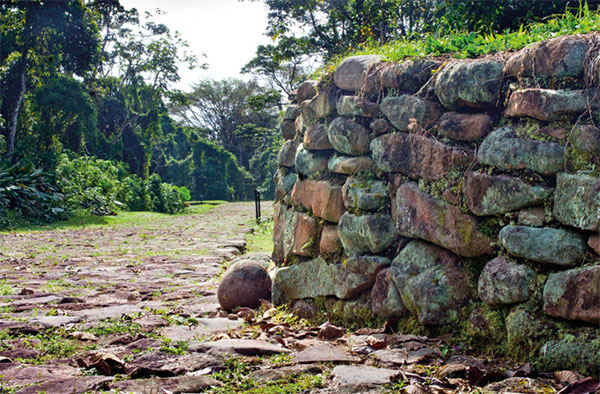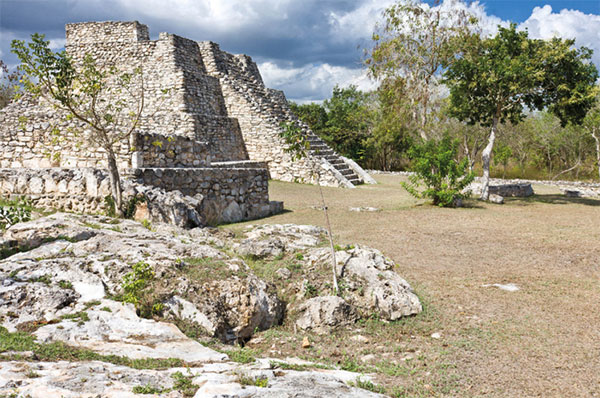THE MAYAN CALENDAR
The observation of the heavens, and the calculation of time based on the movement of the stars, the sun, and the moon, was of the utmost importance to the Maya. Many great Maya sites, such as Chichén Itzá, had observatories from where the experts could calculate the calendar, and they proved to be extremely accurate.
The Maya developed three different calendar systems. The first consisted of 20 named days, which interlocked like a cogwheel with the numbers one to 13, giving a total cycle of 260 days. Alongside this system was one more closely based on the sun’s movement. In this calendar, there were 18 months of 20 days. At the end of the year came five days to complete the solar cycle (the extra quarter-day of the annual solar cycle was ignored). These two calendars, one based on 260 days, the other on 365, came back to their starting point every 18,980 days, or 52 years.
The Maya also developed a system for calculating longer dates. Confusingly, this seems to have been based on a year made up of 360 rather than 365 days, known as a tun. The system, called the Long Count, came into use during the Classic Maya period, and is based on the great cycle of 13 baktuns – a period of 1,872,000 days, or 5,125 years. The present cycle was due to end on December 21, 2012, which doomsayers thought would be the end of the world.
Maya society was highly structured, with strict divisions between the classes. Most numerous were the peones, at the bottom of the scale, whose primary role was to work the land intensively to provide food for the community. In addition, they performed regular military service duties. But their most lasting contribution was to provide the labor needed to construct the temples found in the center of every Maya city. These great structures were achieved by human power alone, without the use of wagons or wheelbarrrows – the Maya did not have the wheel – and without the aid of any draft animals such as horses, mules, or oxen.
Down south
Beyond El Salvador and down through Panama, the pre-Columbian cultures were predominantly speakers of the Chibchan languages at the time of European contact. These were mostly small agrarian and trading societies that were influenced by their Mesoamerican neighbors, learning to fashion goods from stone, jade, and gold.
These groups with diverse languages and cultures lived throughout the southern region in small chiefdoms, cultivating crops like yuca, corn, pejibaye (the bright orange fruit of the peach palm), and numerous other plants. They supplemented their diets with wild fruits and game from the forests, fish and shrimp from the rivers, and crustacea and small oysters from the ocean. Some groups even had small stone cities, such as Guayabo near present day Turrialba in the Costa Rican highlands, which was built with wide, cobblestone walkways, freshwater springs bubbling out of stone-lined pools, and a stone aqueduct system carrying fresh water to some of the stone mounds on which houses were built.

Restored roadway and wall at the Guayabo National Monument and Park.
The Maya had no metal tools – they were ignorant of iron and bronze – yet they produced a mass of finely worked gold objects, jade carvings, and pottery.
The Spanish colonists gave Indigenous people the names by which we know them today (which was often the name of the chief at the time of the Conquest). We do not know what the people called themselves. Since some groups were completely wiped out before the Spanish arrived, we do not have names for them or know what languages they spoke. Because of this, archeologists usually refer to Indigenous groups by the areas in which they lived.
A culture in decline
By the 9th century AD, there were signs that Maya culture was in decline. Most experts now concur that a long drought was the primary factor, perhaps brought on by forest clearance and overpopulation.
Whatever the reason for this decline, the large centers in Guatemala and Chiapas were abandoned. Other archeologists argue that there was no sudden collapse, but that the hub of Maya culture moved to the northern lowlands of the Yucatán, to the Puuc region, and above all, to the great center of Chichén Itzá. Over a lengthy period of time, an immense and elaborate ceremonial center was built on this site in the north of the Yucatán Peninsula. At its heart was the sacred cenote or pool, which was a place of pilgrimage for people throughout the region. Thousands of votive offerings, as well as the remains of human sacrifice, have been discovered in the mud at the bottom of this pool.
Chichén Itzá itself is a hybrid of styles and influences, which suggests that the Maya came into contact with, or had been conquered by, groups from farther north in Mexico. The Toltecs brought in the worship of Kukulcán, a feathered serpent worshiped in other Mexican cultures as Quetzalcoatl. The most important building at Chichén Itzá, the so-called Castillo, is a temple built in his honor, which is clearly in the style of the Toltec Maya. At some point in the 13th century, however, Chichén Itzá was also abandoned, as power shifted at the start of the Postclassic era.
Defensive strongholds
The center of Postclassic Yucatán was Mayapán, a walled city in the west of the Yucatán Peninsula. As many as 12,000 people are thought to have lived in this important trading city, which covered more than 5 sq km (2 sq miles) of land and where up to 2,000 dwellings have been discovered. Although the Itzá did build temples and various other ceremonial buildings, they had lost many of the skills of the Classic Maya. Mayapán appears to have been the defensive redoubt of a warlike group of people who exacted tribute from neighboring tribes.
Another center built during this last phase of the Classic Maya culture was the breathtaking site of Tulum, on the Caribbean coast of the Yucatán Peninsula (for more information, click here). This too was a defensive stronghold, surrounded by walls on three sides and the ocean on the fourth. Its buildings, paintings, and inscriptions show it to have been a mixture of styles and influences. Its isolated position means that it may have survived into the Spanish era.
In 1441, Mayapán was overrun by its enemies. Mayapán was the last of the major Maya centers; when the Spaniards arrived 150 years later they found the sites deserted, and the Maya of Mexico living in small, dispersed groups.

The ruins of Mayapán.
Warring local factions
The Maya in the Guatemalan highlands underwent a similar fate. Toltecs arrived in the region from farther north in the 13th century. They appear to have overcome the local Indigenous Maya, and formed several local empires. The most powerful of these were the K’iche’, whose capital was K’umarkaaj. Other groups included the Kaqchikel and the Mam, but these last two were conquered by the K’iche’ in the 15th century. But when Quicab, the powerful leader of the K’iche’, died in 1475, the other Guatemalan Maya tribes broke away from their rule. As in Mexico, when the Spanish arrived they found the local tribes at war with each other, and were quick to exploit this enmity to their own advantage.